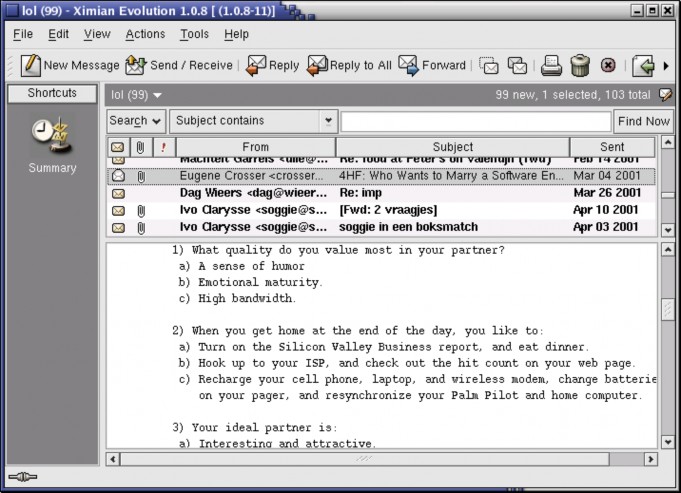< Previous | Contents | Next >
localhost.localdomain: anonymous/[email protected]: IDLE
Of course, the same happens when you open connections to remote hosts: either a daemon answers directly, or a remote (x)inetd starts the service you need and stops it when you quit.
![]()
10.3.2. Mail
10.3.2.1. Servers
Sendmail is the standard mail server program or Mail Transport Agent for UNIX platforms. It is robust, scalable, and when properly configured with appropriate hardware, handles thousands of users without blinking. More information about how to configure Sendmail is included with the sendmail and sendmail-cf packages, you may want to read the README and README.cf files in /usr/share/doc/sendmail. The man sendmail and man aliases are also useful.
Qmail is another mail server, gaining popularity because it claims to be more secure than Sendmail. While Sendmail is a monolithic program, Qmail consists of smaller interacting program parts that can be better secured. Postfix is another mail server which is gaining popularity.
These servers handle mailing lists, filtering, virus scanning and much more. Free and commercial scanners are available for use with Linux. Examples of mailing list software are Mailman, Listserv, Majordomo and EZmlm. See the web page of your favorite virus scanner for information on Linux client and server support.
Amavis and Spamassassin are free implementations of a virus scanner and a spam scanner.
![]()
10.3.2.2. Remote mail servers
The most popular protocols to access mail remotely are POP3 and IMAP4. IMAP and POP both allow offline operation, remote access to new mail and they both rely on an SMTP server to send mail.
While POP is a simple protocol, easy to implement and supported by almost any mail client, IMAP is to be preferred because:
• It can manipulate persistent message status flags.
• It can store as well as fetch mail messages.
• It can access and manage multiple mailboxes.
• It supports concurrent updates and shared mailboxes.
• It is also suitable for accessing Usenet messages and other documents.
• IMAP works both on-line and off-line.
• it is optimized for on-line performance, especially over low-speed links.
![]()
10.3.2.3. Mail user-agents
There are plenty of both text and graphical E-mail clients, we'll just name a few of the common ones. Pick your favorite.
The UNIX mail command has been around for years, even before networking existed. It is a simple interface to send messages and small files to other users, who can then save the message, redirect it, reply to it etcetera.
While it is not commonly used as a client anymore, the mail program is still useful, for example to mail the output of a command to somebody:
mail <[email protected]> < cv.txt
The elm mail reader is a much needed improvement to mail, and so is pine (Pine Is Not ELM). The mutt
mail reader is even more recent and offers features like threading.
For those users who prefer a graphical interface to their mail (and a tennis elbow or a mouse arm), there are hundreds of options. The most popular for new users are Mozilla Mail/Thunderbird, which has easy anti-spam configuring options, and Evolution, the MS Outlook clone. Kmail is popular among KDE users.
Figure 10-1. Evolution mail and news reader

There are also tens of web mail applications available, such as Squirrelmail, Yahoo! mail, gmail from Google and Hotmail.
An overview is available via the Linux Mail User HOWTO.
Most Linux distributions include fetchmail, a mail-retrieval and forwarding utility. It fetches mail from remote mail servers (POP, IMAP and some others) and forwards it to your local delivery system. You can then handle the retrieved mail using normal mail clients. It can be run in daemon mode to repeatedly poll one or more systems at a specified interval. Information and usage examples can be found in the Info pages; the directory /usr/share/doc/fetchmail[-<version>] contains a full list of features and a FAQ for beginners.
The procmail filter can be used for filtering incoming mail, to create mailing lists, to pre-process mail, to selectively forward mail and more. The accompanying formail program, among others, enables generation of auto-replies and splitting up mailboxes. Procmail has been around for years on UNIX and Linux machines and is a very robust system, designed to work even in the worst circumstances. More information may be found in the /usr/share/doc/procmail[-<version>] directory and in the man pages.


 Documentation
Documentation